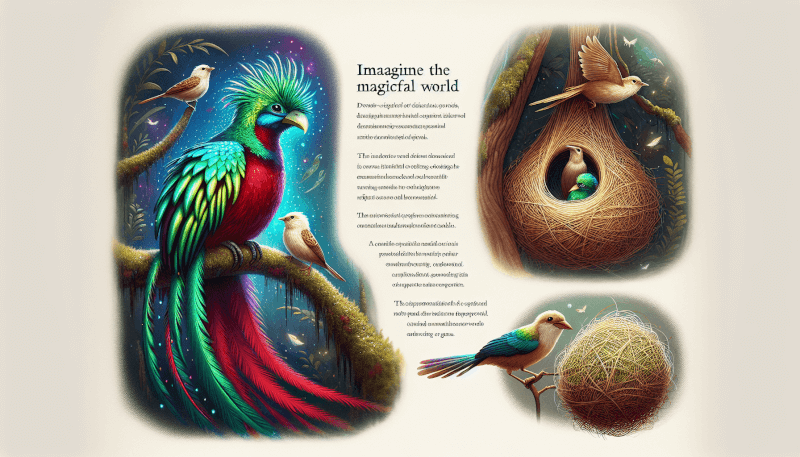Have you ever wondered about the colorful and fascinating world of unique bird species? These enchanting creatures possess extraordinary features and behaviors that set them apart from other birds. From the vibrant plumage of the resplendent quetzal to the mesmerizing courtship dances of the Vogelkop superb bird-of-paradise, each species has its own captivating story to tell. Join us on a journey into the diverse and intriguing world of these extraordinary avian beings.
Unique Bird Species
Birds are fascinating creatures that exhibit a remarkable diversity in their biology and behavior. Within this intricate tapestry of avian life, there are certain species that stand out due to their unique characteristics and adaptations. In this article, we will explore the definition of unique bird species and delve into their distinctive physical features, adaptations, nesting behaviors, and reproductive strategies. We will also discuss their role in ecosystem dynamics and their conservation status.

Definition of Unique Bird Species
When we refer to unique bird species, we are referring to those that possess distinctive characteristics, adaptations, and behaviors that set them apart from other birds. These features may be genetic, physical, behavioral, or ecological in nature. Unique bird species are often deeply specialized for their particular habitats or lifestyles, making them highly adapted to their environments. Their distinctive traits make them valuable subjects for scientific study and conservation efforts.
Characteristics of Unique Bird Species
Unique bird species exhibit a range of characteristics that contribute to their distinctiveness. One key characteristic is their specialized physical features, which can include adaptations for flying, feeding, and camouflage. These species may also display exceptional coloration and feather patterns, allowing them to blend seamlessly into their surroundings or attract mates during courtship displays. Additionally, unique bird species often possess specialized beak structures that enable them to acquire and process specific types of food.
Adaptations of Unique Bird Species
Distinctive Physical Features
Unique bird species often possess physical attributes that are distinctly different from those of other birds. For example, the North American flamingo stands out with its vibrant pink plumage and long, slender legs that facilitate its feeding behavior in shallow waters. Another example is the kiwi, a flightless bird from New Zealand, which has adapted to a nocturnal lifestyle and possesses a long, sensitive beak for probing the forest floor in search of food.
Specialized Beak Structures
The beak, or bill, is a versatile tool for many bird species, and unique bird species have evolved specialized beak structures to suit their dietary needs. For instance, the iconic toucan has a large, colorful beak that helps it grasp and manipulate fruits. On the other hand, the hummingbird has a long, thin beak that allows it to extract nectar from flowers. These adaptations demonstrate the incredible diversity of beak structures among unique bird species.
Coloration and Feather Patterns
Coloration and feather patterns in birds serve various purposes, including camouflage, mate attraction, or signaling dominance. The male peacock, renowned for its vast, iridescent tail feathers, uses its elaborate display during courtship rituals to attract a female mate. In contrast, the male and female penguins have a monochromatic coloration that blends with their icy habitats, providing camouflage from predators.
Endangered Unique Bird Species
Sadly, many unique bird species are currently facing the threat of extinction due to a variety of factors. The causes of endangerment can range from habitat loss and degradation to pollution, climate change, and the illegal wildlife trade. The destruction of critical breeding and foraging grounds, such as wetlands and forests, deprives these birds of their essential resources. Pollution from industrial activities and pesticides further jeopardizes their survival by contaminating their food sources.
Conservation Efforts
To combat the decline of unique bird species, conservation efforts have been implemented worldwide. These initiatives aim to protect and restore habitats, enforce strict regulations against poaching and illegal trading, and raise awareness among local communities and the general public. Conservation organizations work tirelessly to support breeding programs, conduct research, and implement conservation strategies that foster the recovery and stability of endangered bird populations.
Notable Examples
Some notable examples of endangered unique bird species include the California condor, an iconic bird of prey in North America that was nearly driven to extinction. Through intense captive breeding programs and habitat protection, the population of California condors has gradually increased, offering hope for their continued survival. Another example is the Kakapo, a flightless parrot from New Zealand that has faced severe declines due to introduced predators and habitat loss. Intensive management efforts have been successful in preserving this critically endangered species.

Migration Patterns of Unique Bird Species
Long-Distance Migrations
Migration is a remarkable phenomenon observed in many bird species, and unique bird species are no exception. Some birds undertake extraordinary long-distance migrations, traveling thousands of miles each year in search of food and breeding grounds. The Arctic tern holds the record for the longest migration, traveling from the Arctic to the Antarctic and back again, covering a distance of over 40,000 miles annually. These epic journeys highlight the incredible endurance and navigational abilities of unique bird species.
Seasonal Patterns
Migration patterns among unique bird species often follow distinct seasonal patterns. For instance, the ruby-throated hummingbird, a small migratory bird found in North America, embarks on an arduous journey from its breeding grounds to its wintering areas in Central America. These seasonal movements allow birds to capitalize on the seasonal fluctuations in food availability and provide them with optimal breeding conditions.
Navigation Strategies
Unique bird species employ a range of navigation strategies to undertake their migration journeys. They may rely on a combination of celestial cues, such as the position of the sun or stars, geomagnetic fields, landmarks, and even olfactory senses. Recent research has suggested that some birds possess magnetoreception, the ability to perceive Earth’s magnetic field, which aids them in orienting themselves during migration. These astonishing navigational abilities ensure that unique bird species successfully navigate their way to their destination, often with remarkable precision.
Unique Bird Songs and Calls
Vocal Communication
The avian world is renowned for its diversity of vocalizations, and unique bird species contribute to this symphony with their distinct songs and calls. Vocalization plays a vital role in bird communication, serving a variety of purposes, including mate attraction, territorial defense, and identifying individuals within a group. Each unique bird species has its own repertoire of songs and calls, allowing them to communicate effectively with their conspecifics and establish their presence in their respective habitats.
Complexity and Variability
Unique bird species exhibit a remarkable variety in the complexity and variability of their vocalizations. Some species, such as the nightingale and mockingbird, are known for their incredible ability to mimic the sounds of other species or environmental noises. This mimicry adds a layer of richness and complexity to their songs, enabling them to create elaborate melodies that can span great lengths. Other species may produce simple, repetitive calls that serve specific purposes, such as flock cohesion or alarm signaling.
Use in Courtship and Territory Defense
Bird songs are often a focal point during courtship displays, as they serve as a means of attracting potential mates. Male birds may perform intricate song sequences, showcasing their vocal prowess to females. These songs function as indicators of the male’s genetic fitness and serve to establish bonds between potential mates. Moreover, bird songs are crucial for territory defense. Male birds establish and maintain their territories through vocal displays, which signal their presence and discourage intruders from encroaching on their territory.
Unique Nesting Behaviors
Construction Techniques
Unique bird species employ a wide range of construction techniques when building their nests. Some birds, like the bowerbird, are known for their elaborate construction abilities. Male bowerbirds create intricate structures, or bowers, often adorned with carefully arranged objects like flowers, shells, or brightly colored objects, to impress female mates. In contrast, other bird species, such as the weaverbirds, construct complex woven nests using twigs and grass, exhibiting remarkable architectural prowess.
Unusual Nest Locations
Unique bird species exhibit a plethora of nesting habits, including nesting in unconventional or protected locations. For instance, the Atlantic puffin chooses to nest in burrows along cliffs, providing protection from predators and harsh weather conditions. Some bird species, like the African palm swift, build their nests in palm trees, cleverly attaching them to the fronds in such a way that they remain hidden from potential predators and human disturbance.
Parental Care
Many unique bird species exhibit remarkable parental care behaviors, ensuring the survival and well-being of their offspring. Both male and female birds can contribute to parental care activities, including nest building, incubation of eggs, and feeding of the nestlings. Some bird species, like the Emperor penguins, engage in cooperative parenting, with males taking on the responsibility of incubating the eggs during harsh Antarctic winters while females go in search of food.
Unique Breeding Strategies
Monogamy vs Polygamy
Unique bird species employ various breeding strategies, ranging from monogamy to polygamy. Monogamous species form strong pair bonds between males and females, usually remaining together for extended periods and raising offspring as a team. Examples of monogamous birds include the albatross and the bald eagle. On the other hand, polygamous species engage in multiple mating partnerships, with males often competing for access to females. The sage grouse is a notable example of a polygamous bird, where males engage in competitive mating displays, known as lekking.
Lekking Behavior
Lekking is a unique breeding behavior exhibited by certain bird species, in which males aggregate in specific locations to engage in competitive displays to attract females. These displays often involve elaborate vocalizations, colorful plumage, and physical movements to assert dominance and attract mates. The greater sage-grouse is renowned for its elaborate lekking behavior, with males gathering in large groups and performing intricate displays to entice females.
Brood Parasitism
Some unique bird species have evolved a reproductive strategy known as brood parasitism, where they lay their eggs in the nests of other bird species, known as hosts. This behavior is observed in species like the brown-headed cowbird, which lays its eggs in the nests of other bird species, leaving the hosts to raise its young. Although this strategy can be detrimental to the host species, it is an effective way for brood parasitic birds to ensure the survival of their offspring by shifting the burden of parental care onto other individuals.
Feeding Habits of Unique Bird Species
Carnivorous Birds
Unique bird species exhibit a diverse range of feeding habits and dietary preferences. Some birds, like raptors, are carnivorous, relying on a diet of small mammals, reptiles, and other birds. The majestic bald eagle, for instance, feeds primarily on fish. Birds of prey, such as the peregrine falcon, employ incredible hunting techniques, diving at high speeds to catch their prey in mid-air.
Herbivorous Birds
In contrast to carnivorous birds, herbivorous bird species feed primarily on plant material. This can include fruits, seeds, nectar, and even leaves. The iconic toucan, for example, has a diet consisting mainly of fruits, which its specialized beak allows it to pluck and consume. Other herbivorous species, such as the African grey parrot, have evolved to include seeds, nuts, and even clay in their diet.
Specialized Feeding Techniques
Unique bird species often possess specialized feeding techniques that enhance their efficiency in acquiring food. For instance, the flamingo’s bill is uniquely adapted to filter-feed on small crustaceans and algae. By maintaining an upside-down posture and rapidly moving their bill from side to side, they create water currents that draw in food particles. Additionally, some species have developed tools to access food sources that are less accessible, such as the woodpecker’s strong bill, which it uses to excavate insect larvae from tree bark.
Birds with Unique Reproductive Systems
Sexual Dimorphism
Sexual dimorphism is a common phenomenon among unique bird species, where males and females exhibit different physical characteristics. This dimorphism can manifest in various ways, including differences in size, coloration, or plumage patterns. The vibrant plumage of male birds, such as the peacock or the resplendent quetzal, often serves to attract females during courtship rituals.
Sequential Hermaphroditism
Sequential hermaphroditism is a remarkable reproductive strategy observed in certain bird species, where individuals change sex at some point during their lives. The clownfish, for example, is commonly known for this behavior, but it is also observed in some bird species, such as the blacktail gull. In this species, individuals start their lives as female and transition to male as they grow older.
Extraordinary Mating Rituals
Unique bird species often exhibit extraordinary mating rituals, including elaborate courtship displays and physical movements, that are highly specific to each species. The Wilson’s bird-of-paradise, native to Papua New Guinea, is renowned for its extravagant mating rituals, featuring vibrant plumage, intricate dances, and breathtaking displays of feathers. These behaviors are crucial for attracting a mate and ensuring reproductive success.
Impact of Unique Bird Species on Ecosystems
Seed Dispersal
Birds play a crucial role in the dispersal of seeds, often unwittingly aiding in the distribution of plants across vast distances. As birds consume fruits or seeds, they may deposit them far away from the parent plant, facilitating the colonization of new habitats and aiding in the regeneration of ecosystems. This seed dispersal process is particularly important in areas where other agents of dispersal, such as wind or water, are limited.
Insect Control
Many unique bird species contribute to insect control within ecosystems, as their diets include a significant proportion of insects. Insectivorous birds, such as warblers and flycatchers, actively hunt and consume large quantities of insects, helping to maintain balance and control within insect populations. By regulating insect numbers, these birds contribute to the overall health and stability of ecosystems, preventing outbreaks of pests and minimizing crop damage.
Pollination
Some unique bird species, such as hummingbirds, play a vital role in the pollination of flowering plants. As these birds feed on nectar from flowers, they inadvertently transfer pollen from one flower to another, facilitating the reproduction of the plant. The long, thin beak of the hummingbird is perfectly adapted to extract nectar from flowers, often dipping its beak deep into the floral tubes and inadvertently picking up and transferring pollen in the process.
In conclusion, unique bird species offer an array of captivating features and behaviors that set them apart from their avian counterparts. From their distinctive physical features and specialized beak structures to their unique nesting behaviors and exceptional mating strategies, these birds contribute to the breathtaking diversity found in the natural world. Furthermore, their impact on ecosystems, through seed dispersal, insect control, and pollination, highlights their importance for the overall health and functioning of ecosystems. As we strive to conserve and protect these exceptional creatures, it is essential that we recognize and appreciate their uniqueness, ensuring their continued existence for generations to come.


